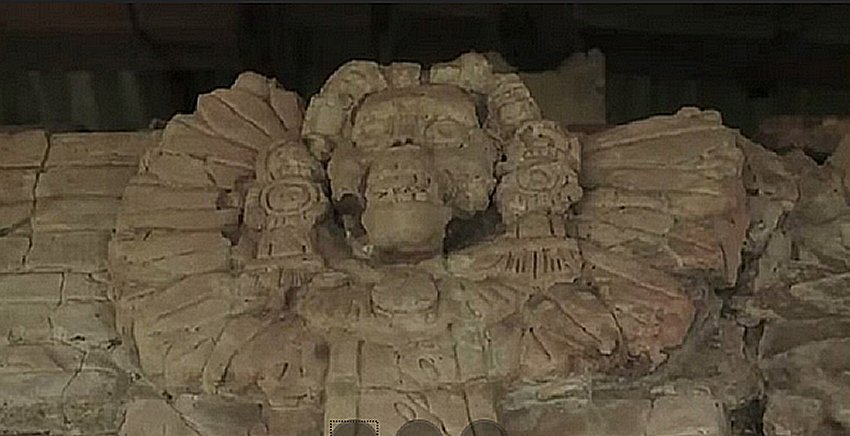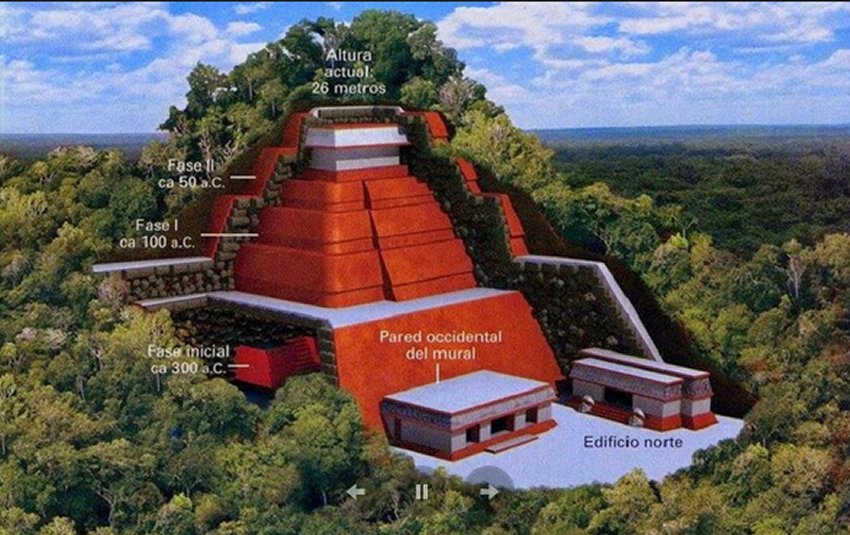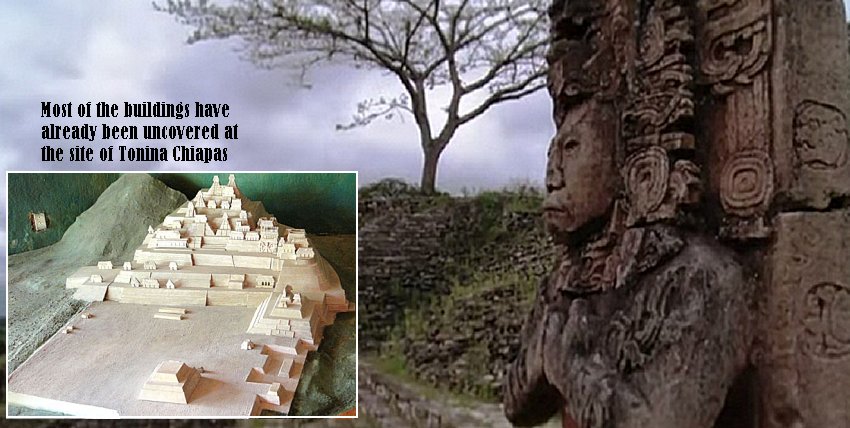‘Tonina Chiapas’ Mayan Pyramid In Southern Mexico Is Among The Largest Yet Found
A. Sutherland - AncientPages.com - The representation of the Sacred Mountain of the Mayas, is located only ten kilometers from a village Ocosingo in Chiapas between the famous Palenque and San Cristobal de las Casas, in the middle of the Lacandona jungle.
Fragment of glyphic text on the wall in the Tonina Palace. Image credit: INAH
Five years after its discovery, it has now been revealed the pyramid is among the largest yet found. The acropolis of Tonina Chiapas in southern Mexico has 208 stone steps leading from its base to its apex and is 75 meters or 65 meters tall.
A wall with a rich glyphic text including the complete name of the ruler that founded one of the most powerful Maya military seigniories was found in Tonina Archaeological Zone, in Chiapas, in southern Mexico.
The structure was constructed on a hill with seven platforms that made up a labyrinth.
The Mayans built palaces, temples, and altars to honor the sky, death, and the underworld. Between the 6th and 10th centuries, in Tonina lived warrior princes who ruled the cities in the basin of the River Usumacinta, including Palenque, Bonampak, and Yaxchila. This contradicts the idea of the Mayan world as being peaceful and mathematical.
The bas reliefs in stone and stucco, like the 'Four Suns' (Los cuatro soles) (and the 'Mural of skulls' (El mural de las calaveras), have clearly Toltec influences and represent particularly outstanding features.
Recent excavations have proven the Mayan city at Tonina to be double the size previously anticipated.
It is also being described as unique in that the city has seven clearly defined districts within its 10-12 ha boundary, each dedicated to a different purpose — such as palaces, temples, housing and administration.
The site has been classified as one of Mexico’s most important, with more than 300 hieroglyphic texts so far identified.
Tonina Chiapas according to an earlier impression of what the temple may look like. Image credit: INAH
The magnificent Tonina temple was not built on a hill as it was previously believed. Instead, the structure is artificial because it was almost entirely constructed by the ancient Maya architects.
A stone sarcophagus unearthed at the site of Tonina, has been dated by researchers to 840-900 AD. Inside were found the remains of bones and pottery, though an identity has not yet been established.
However, a hieroglyphic text found on a wall a few months ago has been found to carry the full name and a portrait of the Mayan chief who built the most important fortified house in the city, K’inich B’aaknal Chaahk — the sixth ruler of the 14 known to have ruled the city.
It is important to mention that according to archaeologist Dr Carlos Pallan Gayol from the National Institute of Anthropology and History (INAH), the wall is fundamental because it sheds more light on a chapter of Tonina history between 680 and 715 AD when the 6th seignior appears in the dynastic sequence of the site.
Until now, it is known that K’inich B’aaknal Chaahk was the ruler with greater political and hegemonic power in Tonina, a city known in its times as Po’ (white - in Mixe-Zoque language).”
Behind the wall was found a throne and inscriptions holding the dates of March and June of AD708.
Further translation of hieroglyphs will give a much better understanding as to why the Mayan civilization collapsed.
Written by – A. Sutherland - AncientPages.com Senior Staff Writer
Copyright © AncientPages.com All rights reserved. This material may not be published, broadcast, rewritten or redistributed in whole or part without the express written permission of AncientPages.com
Expand for referencesMore From Ancient Pages
-
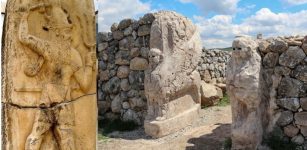 Drought Accelerated Hittite Empire Collapse – New Study Suggests
Archaeology | Feb 12, 2023
Drought Accelerated Hittite Empire Collapse – New Study Suggests
Archaeology | Feb 12, 2023 -
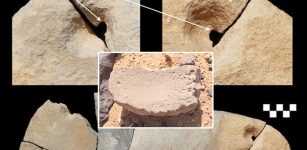 Study: Grinding Tools Were Once Used In Plant, Pigment And Bone Processing At Jebel Oraf Site, Saudi Arabia
Archaeology | Oct 6, 2023
Study: Grinding Tools Were Once Used In Plant, Pigment And Bone Processing At Jebel Oraf Site, Saudi Arabia
Archaeology | Oct 6, 2023 -
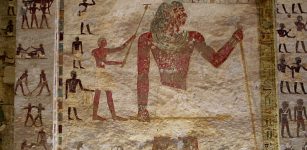 Rock-Cut Tombs Of Beni Hasan With Spells, Prayers To Osiris And Anubis And Map To Underworld
Civilizations | Feb 3, 2017
Rock-Cut Tombs Of Beni Hasan With Spells, Prayers To Osiris And Anubis And Map To Underworld
Civilizations | Feb 3, 2017 -
 Excavation Of A Mysterious 5,000-Year-Old Tomb Linked To King Arthur Has Started
Archaeology | Jul 5, 2022
Excavation Of A Mysterious 5,000-Year-Old Tomb Linked To King Arthur Has Started
Archaeology | Jul 5, 2022 -
 On This Day In History: ENIGMA The Secret Code Used By Germans Was Finally Broken- On July 9, 1941
News | Jul 9, 2016
On This Day In History: ENIGMA The Secret Code Used By Germans Was Finally Broken- On July 9, 1941
News | Jul 9, 2016 -
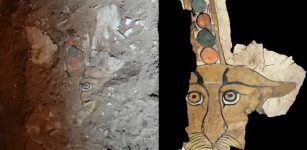 Rare Ancient Leopard Painting Discovered On Sarcophagus In Aswan, Egypt
Archaeology | Feb 25, 2020
Rare Ancient Leopard Painting Discovered On Sarcophagus In Aswan, Egypt
Archaeology | Feb 25, 2020 -
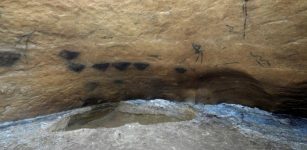 Cave Art In ‘Painting Room’ – At Ojo Guareña (Burgos) Is Over 12,000 Years Old
News | Oct 2, 2020
Cave Art In ‘Painting Room’ – At Ojo Guareña (Burgos) Is Over 12,000 Years Old
News | Oct 2, 2020 -
 12,000-Year-Old Ice Age Stone Tools Found – Earliest Dated Evidence For Human Activity in Scotland
Archaeology | Oct 10, 2015
12,000-Year-Old Ice Age Stone Tools Found – Earliest Dated Evidence For Human Activity in Scotland
Archaeology | Oct 10, 2015 -
 Bizarre Story Of Scottish Penkaet Castle
Featured Stories | Apr 18, 2020
Bizarre Story Of Scottish Penkaet Castle
Featured Stories | Apr 18, 2020 -
 America’s Native Population Arises From A Single Wave Of Asian Migration – Dental Anthropologists Say
Archaeology | Dec 19, 2023
America’s Native Population Arises From A Single Wave Of Asian Migration – Dental Anthropologists Say
Archaeology | Dec 19, 2023 -
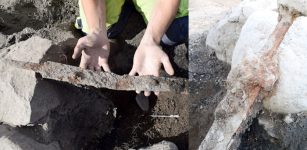 Unexpected Discovery Of Two Viking Swords In Upright Position In Sweden
Archaeology | Oct 27, 2022
Unexpected Discovery Of Two Viking Swords In Upright Position In Sweden
Archaeology | Oct 27, 2022 -
 New Light On Appearance Of Scythians In Northern Black Sea Region
Archaeology | Mar 11, 2017
New Light On Appearance Of Scythians In Northern Black Sea Region
Archaeology | Mar 11, 2017 -
 Power Of Water In Beliefs Of Ancient Cultures
Featured Stories | Apr 9, 2019
Power Of Water In Beliefs Of Ancient Cultures
Featured Stories | Apr 9, 2019 -
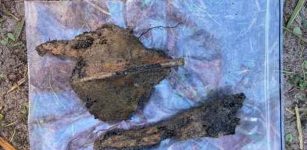 Intrepid Southern Voyage In The Wake Of Early Waka
Archaeology | Jun 28, 2023
Intrepid Southern Voyage In The Wake Of Early Waka
Archaeology | Jun 28, 2023 -
 How Extensively Did Early Farmers Utilize Europe’s Rich Forests For Raising Their Livestock?
Archaeology | Nov 13, 2024
How Extensively Did Early Farmers Utilize Europe’s Rich Forests For Raising Their Livestock?
Archaeology | Nov 13, 2024 -
 Ancient Cities Built By Biblical Giants – Archaeological Evidence
Ancient Mysteries | Jun 2, 2018
Ancient Cities Built By Biblical Giants – Archaeological Evidence
Ancient Mysteries | Jun 2, 2018 -
 UK’s Oldest Human DNA Reveals Two Genetically Distinct Human Groups Migrated To Britain At The End Of Last Ice Age
Archaeology | Oct 24, 2022
UK’s Oldest Human DNA Reveals Two Genetically Distinct Human Groups Migrated To Britain At The End Of Last Ice Age
Archaeology | Oct 24, 2022 -
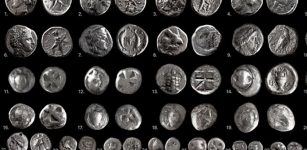 Incredible Treasure Of Extremely Rare Greek Coins And Aqueduct Found In Ancient Tenea, Greece
Archaeology | Jan 10, 2024
Incredible Treasure Of Extremely Rare Greek Coins And Aqueduct Found In Ancient Tenea, Greece
Archaeology | Jan 10, 2024 -
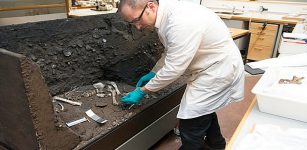 8200-Year-Old ‘Viste Individual’ – DNA Analysis May Shed Light On Early Migration To Norway
Archaeology | Dec 6, 2015
8200-Year-Old ‘Viste Individual’ – DNA Analysis May Shed Light On Early Migration To Norway
Archaeology | Dec 6, 2015 -
 Camas Plant Stewardship In The Pacific Northwest Dates Back More Than 3,500 Years
Archaeology | May 23, 2024
Camas Plant Stewardship In The Pacific Northwest Dates Back More Than 3,500 Years
Archaeology | May 23, 2024


